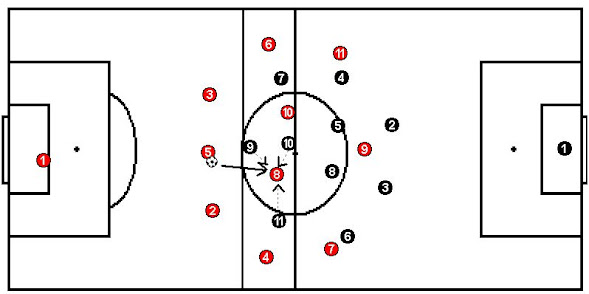Author: Oscar Mendez.
As we know in football/soccer, when the majority of teams find themselves on offensive Phase, normally according to the general principles of all collective sports, we look for certain strategic objectives that our team must take advantage.
This is very basic for all Collective sports.
General Principles of collective sports.
1- Create numerical superiority.
2- Avoid numerical equality
3- Disallow numerical inferiority.
A problem that we often see, either on Club level or National Teams when they compete is how this aspect is not taken into account frequently.
It is often repeated and insisted on, something that will have negative consequences for that team, either because they will lose possession and will be an easy target for that team to be counter-attacked easily.
I am not sure why this happens, but I suspect it can be related to an in-abilty to be unable to see the action following or to not see the game as a Whole (systemic view).
They behave as if that offensive action finished immediately, and the game finishes there and would not change, where the football match we see it is a "subsequent phase of occurring actions one after the other one".
The problem:
When these teams build up offensive actions from the back, we can determine a passive Zone and an active one.
The active one is found where the defensive block of the opposing team is positioned. In this case it is placed as a Mid-block or on Intermediate zone (in 2/3 of the pitch). (Black team in this case in the graph).
When teams are on offensive organization (red team in this case), on build up phase as mentioned before, the teams defending frequently place their forwards behind the defensive midfielders of attacking team, with the team very short in distance and compact.
Also, to make things worse for attacking team, the fullbacks place themselves behind the defensive block as seen on the graph, so the problem on the active zone, where the attacking team is numerically outnumbered and player who receives, will be in very big numerical disadvantage and it will be practically impossible for that team to progress, keep possession of the ball, create a scoring chance or even pressure.
Other times, the fullbacks may move up even though the defensive midfielder may drop back between the two Central Defenders creating on the Active zone a 7 v 11.
This became "fashionable" when Guardiola used this to build up from the back, but was not understood as a tool to create numerical superiority +1 , but rather it is used without taking into account the strategy behind it.
The question is, if the defending team defends with only one striker or forward, why does the defensive midfielder drop back if the attacking team already has numerical superiority.
At first sight, someone might say, to create a 3v1.
The following question would be, once we can progress to that active zone, the attacking team would be on a 7 v 11 (10 players + 1 goalkeeper).
This numerical inferiority that the attacking team has on Build up phase, would it be enough to keep progressing and not lose the ball?
Many of the players on the red team, would be seriously outnumbered by the black team.
This "Problem" is seen frequently, many times at every level.
1st Problem- To be able to progress.
If we are able to pass to a teammate on this Active zone, he/she will be seriously outnumbered and probably will be unable to keep possession of the ball or allow the team to progress.
Another problem is how we press after losing the able to gain the ball immediately after losing it, either because it will be very advantageous because we would be close to the opposing goal, would not give time for the opposing team to re-organize.
This problem can be originated on seeing possession as a means for something and not as an objective on its own, without taking into account its strategy.
Possession and positional football it is not generated by aesthetic appearances but rather a strategy to how our team will play, attack, press and defend once again.
In other words, organize and re organize.
3rd Problem- Create and occupy free space.
To know how to create, see, occupy and take advantage of free space.
This first must be understood and recognized by coaches, later it must be known how to be taught and later footballers must recognize it and be able to execute it in real game situations.
4th Problem- The game rythm.
The game rhythm (Ritmo de juego) , is an aspect that in Spain, we consider rather important.
It can be resumed just by a Phrase said by famous Uruguayan footballer "Alvaro Recoba".
"You can not run at the same speed and intensity when you are attacking than when you are defending".
The rhythm of the team will not be the same when the team immediately loses the ball than when it gains it and it can not transition quickly to the opposing goal, and has to build up changing to Offensive Organization.
All players must progress together (viajar juntos), maintain a positional organization so that when we lose the ball we can press immediately to recover the ball and attack or counter attack the opponent.
Modern football has this characteristic, like it or not.
5th Problem- Lack of mobility.
Mobility also is a key aspect, although it should be done in a positional fashion within the space that the player must occupy.
"The garnish (Physical Training) has become more important than the Steak (football game)".
Juanma Lillo.










No comments:
Post a Comment